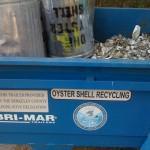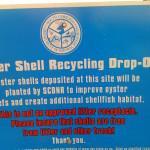 From the “meant to write that up a long time ago and never got to it” files comes a post about recycling in Charleston, S.C. Only in the last couple years have parts of South Carolina – such as where my sister used to live on James Island – started recycling programs in their neighborhoods for glass, plastic, and paper. There used to be a “just throw everything in the trash” mentality. That there are now recycling efforts underway is good news in itself. What is also interesting is that oyster shells, the byproduct from a very historic and important industry in the Charleston area, were already being recycled. This is a great example of how programs need to be tailored to the realities of local businesses and residents. If there is a well-defined reason to institute a policy with benefits that the local community can see and appreciate, resistance to a particular policy tends to be lower and chances of implementation increase. Oysters have several benefits besides being a local delicacy and contributing to the economy:
From the “meant to write that up a long time ago and never got to it” files comes a post about recycling in Charleston, S.C. Only in the last couple years have parts of South Carolina – such as where my sister used to live on James Island – started recycling programs in their neighborhoods for glass, plastic, and paper. There used to be a “just throw everything in the trash” mentality. That there are now recycling efforts underway is good news in itself. What is also interesting is that oyster shells, the byproduct from a very historic and important industry in the Charleston area, were already being recycled. This is a great example of how programs need to be tailored to the realities of local businesses and residents. If there is a well-defined reason to institute a policy with benefits that the local community can see and appreciate, resistance to a particular policy tends to be lower and chances of implementation increase. Oysters have several benefits besides being a local delicacy and contributing to the economy:
- A Harvestable & Renewable Resource: Each year tens of thousands of bushels are harvested recreationally and commercially.
- Estuarine Filters: Adult oysters filter up to 2.5 gallons of water per hour or up to 50 gallons per day.
- Habitat: Oysters build reefs which provide habitat for fish, shrimp, crabs, and other animals. They are an integral part of the marine ecosystem. There are 70 different species that frequent oyster reefs, including; Red Drum, Blue Crabs, Flounder, and Shrimp.
- Erosion Control: Oyster reefs are natural breakwaters that absorb wave energy and protect marsh shorelines from erosion.
The closing of oyster canneries and most shucking houses during [the last 30 years] has resulted in a shortage of shucked oyster shell needed to cultivate and restore oyster beds. The increasing popularity of backyard oyster roasts and by-the-bushel retail sales have contributed to this shortage in that, contrary to the shucking houses and canneries, shells remaining from individual oyster roasts are not usually returned to the estuary to provide a suitable surface to attract juvenile oysters. More often than not, the shell ends up in driveways and landfills. [source]
For more information on oyster spawning, how to properly recycle the shells, and a list of recycling bins in the Charleston area, see the S.C. Department of Natural Resources website.Also, check out Bowen’s Island for a very unique oyster eating experience.[Images from author]




